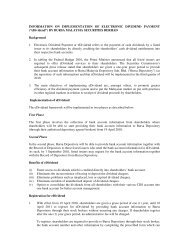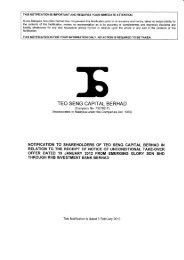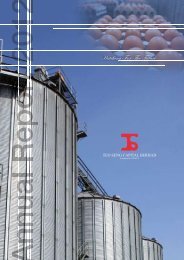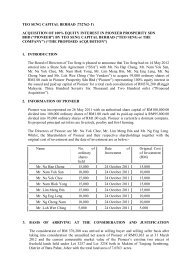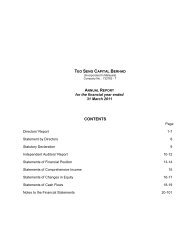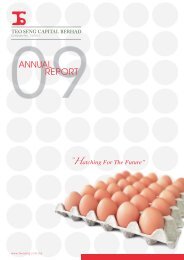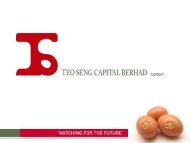LEEKEE INDUSTRIES (M) SDN - teo seng capital berhad
LEEKEE INDUSTRIES (M) SDN - teo seng capital berhad
LEEKEE INDUSTRIES (M) SDN - teo seng capital berhad
Create successful ePaper yourself
Turn your PDF publications into a flip-book with our unique Google optimized e-Paper software.
TEO SENG CAPITAL BERHAD(Incorporated In Malaysia)Company No : 732762 - TNOTES TO THE FINANCIAL STATEMENTSFOR THE FINANCIAL PERIOD FROM 1 APRIL 2012 TO 31 DECEMBER 20124. ACCOUNTING POLICIES AND STANDARDS (CONT’D)4.6 Critical Accounting Estimates and Judgements (Cont’d)(d)Write-down of inventories – Non-livestocksReviews are made periodically by management on damaged, obsolete and slowmoving inventories. These reviews require judgement and estimates. Possiblechanges in these estimates could result in revisions to the valuation of inventories.(e)Classification between investment property and owner-occupied propertiesThe Group determines whether a property qualifies as an investment property, andhas developed a criteria in making that judgement. Investment property is a propertyheld to earn rentals or for <strong>capital</strong> appreciation or both. Therefore, the Groupconsiders whether a property generates cash flows largely independent of the otherassets held by the Group.Some properties comprise a portion that is held to earn rentals or for <strong>capital</strong>appreciation and another portion that is held for use in the production or supply ofgoods or services or for administrative purposes. If these portions could be soldseparately (or leased out separately under a finance lease), the Group accounts forthe portions separately. If the portions could not be sold separately, the property isan investment property only if an insignificant portion is held for use in the productionor supply of goods or services or for administrative purposes.Judgement is made on an individual property basis to determine whether ancillaryservices are so significant that a property does not qualify as investment property.(f)Impairment of trade and other receivablesAn impairment loss is recognised when there is objective evidence that a financialasset is impaired. Management specifically reviews its loans and receivablesfinancial assets and analyses historical bad debts, customer concentrations,customer creditworthiness, current economic trends and changes in the customerpayment terms when making a judgement to evaluate the adequacy of the allowancefor impairment losses. Where there is objective evidence of impairment, the amountand timing of future cash flows are estimated based on historical loss experience forassets with similar credit risk characteristics. If the expectation is different from theestimation, such difference will impact the carrying amount of receivables.Page 48



